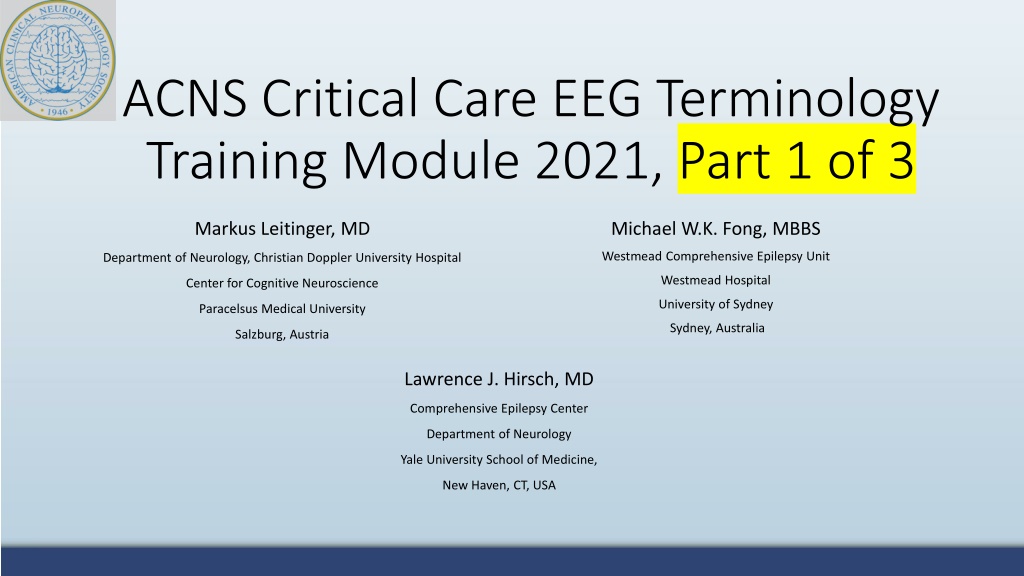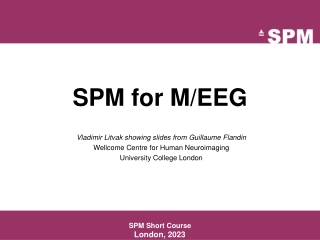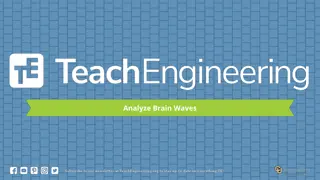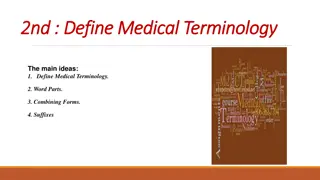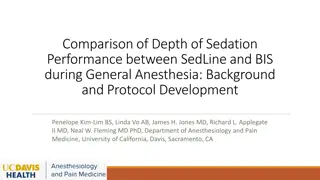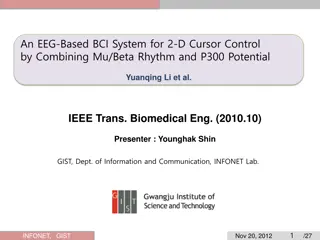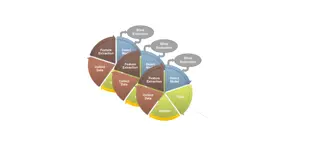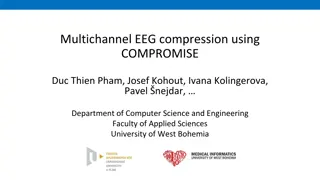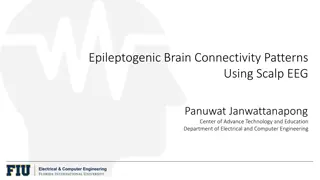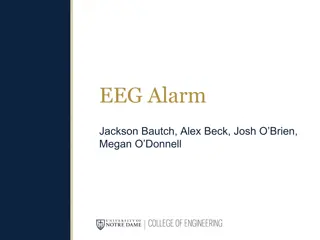Understanding ACNS Critical Care EEG Terminology 2021: Part 1 of 3
This module provides an introduction to the important components of the ACNS standardized critical care EEG terminology for 2021. It discusses common terms and components of EEG background, sporadic epileptiform discharges, rhythmic and periodic patterns (RPPs), electrographic and electroclinical seizures, brief potentially ictal rhythmic discharges (BIRDs), and the ictal-interictal continuum (IIC). For comprehensive details, reference the ACNS guideline.
Download Presentation

Please find below an Image/Link to download the presentation.
The content on the website is provided AS IS for your information and personal use only. It may not be sold, licensed, or shared on other websites without obtaining consent from the author. Download presentation by click this link. If you encounter any issues during the download, it is possible that the publisher has removed the file from their server.
E N D
Presentation Transcript
ACNS Critical Care EEG Terminology Training Module 2021, Part 1 of 3 Markus Leitinger, MD Michael W.K. Fong, MBBS Westmead Comprehensive Epilepsy Unit Department of Neurology, Christian Doppler University Hospital Westmead Hospital Center for Cognitive Neuroscience University of Sydney Paracelsus Medical University Sydney, Australia Salzburg, Austria Lawrence J. Hirsch, MD Comprehensive Epilepsy Center Department of Neurology Yale University School of Medicine, New Haven, CT, USA
Mode of presentation General remarks: This module has been designed to provide a self guided introduction to the important components of the ACNS standardized critical care EEG terminology, 2021 version. It focuses on discussing terms that are commonly used or with a high clinical importance. It does not describe all of the major and minor modifiers (although it includes many). For comprehensive details on all feaures of the terminology please refer to the ACNS guideline that can be found at https://www.acns.org/practice/guidelines, under Continuous EEG Monitoring in Critical Care , or via the Journal of Clinical Neurophysiology https://journals.lww.com/clinicalneurophys/Fulltext/2021/01000/American_Clinical_Neurophysiology_Society_s.1.aspx
Contents for Part 1 of 3 Sequence of topics (follows the full guideline): A. EEG BACKGROUND B. SPORADIC EPILEPTIFORM DISCHARGES C. RHYTHMIC AND PERIODIC PATTERNS (RPPs) D. ELECTROGRAPHIC AND ELECTROCLINICAL SEIZURES [NEW, 2021] E. BRIEF POTENTIALLY ICTAL RHYTHMIC DISCHARGES (BIRDs) [NEW, 2021] F. ICTAL-INTERICTAL CONTINUUM (IIC) [NEW, 2021] Sequence of slides for each topic: 1. Introductory text plus diagram 2. EEG example alone with question at the bottom 3. EEG with explanatory annotations 4. Summary slide
EEG BACKGROUND 1. Symmetry a. Symmetric. b. Mild asymmetry (consistent asymmetry in voltage on an appropriate referential recording of <50% or consistent asymmetry in frequency of 0.5 to 1 Hz). c. Marked asymmetry ( 50% voltage or >1 Hz frequency asymmetry). 2. Predominant Background Frequency When Most Awake or After Stimulation: Beta (>13 Hz), Alpha, Theta, Delta. NOTE: If two or three frequency bands are equally prominent, report each one. 3. Posterior Dominant ( Alpha ) Rhythm (must be demonstrated to attenuate with eye opening; wait >1 second after eye closure to determine frequency to avoid alpha squeak ): Present: Specify frequency to the nearest 0.5 Hz, Absent, Unclear. No consistent voltage differences between sides.
EEG BACKGROUND No consistent frequency differences between sides.
EEG BACKGROUND 4. Continuity a. Continuous b. Nearly Continuous: continuous, but with occasional (1 9% of the record) periods of attenuation or suppression lasting 1 second. c. Discontinuous: A pattern of attenuation/suppression alternating with higher voltage activity, with 10% to 49% of the record consisting of attenuation or suppression. d. Burst attenuation/Burst suppression: A pattern of attenuation/suppression alternating with higher voltage activity, with 50% to 99% of the record consisting of attenuation e. Suppression/attenuation: entirety or near-entirety (>99%) of the record consists of either suppression (all <10 V, as defined above) or low voltage activity (all <20 V but not qualifying as suppression). Specify whether attenuated or suppressed.
EEG BACKGROUND Attenuation percent or Suppression percent: the percent of the record/epoch that is attenuated or suppressed. This can range from 1% to 99%. If <1%, it is considered continuous. If >99%, it is considered either suppressed or attenuated, but not discontinuous. For example, a record with 2 second bursts alternating with 8 seconds of suppression, as shown here, would be Burst-Suppression with a suppression percent of 80%.
How is the background of this EEG best described? Reproduced with permission from Hirsch LJ, Fong MWK, Brenner RP. Atlas of EEG in Critical Care, second edition, Wiley: 2022 (attempt to answer as best as possible before progressing to the explanation on the next slide)
LEFT 80 V ASYMMETRY in VOLTAGE: MILD: < 50% less on one side MARKED: 50% lower voltage RIGHT 30 V CONTINUOUS POLYMORPHIC DELTA ACTIVITY OVER LEFT MID-TEMPORAL (NOT RHYTHMIC) Continuous EEG with voltage asymmetry (marked, lower on right) and slowing on the left, polymorphic delta. Reproduced with permission from Hirsch LJ, Fong MWK, Brenner RP. Atlas of EEG in Critical Care, second edition, Wiley: 2022
How is the background of this EEG best described? Reproduced with permission from Hirsch LJ, Fong MWK, Brenner RP. Atlas of EEG in Critical Care, second edition, Wiley: 2022
Continuous EEG with frequency asymmetry, marked (beta on right and theta with polymorphic delta slowing [boxes] on left) Reproduced with permission from Hirsch LJ, Fong MWK, Brenner RP. Atlas of EEG in Critical Care, second edition, Wiley: 2022
Burst-attenuation pattern: Bursts (>0.5 sec AND >3 phases) of generalized activity; inbetween bursts there is lower amplitude activity (<50% of the higher amplitude portion/ bursts, but 10 V i.e., attenuation, not suppression). Higher voltage activity qualifies as bursts: 0.5s AND 4 phases about 10 phases BURST: 1.5 s ATTENUATION: 3 s BURST: 1 s A: 2 s ATTENUATION (amplit. 10 V): 2.5 s Burst-attenuation pattern Bursts: generalized. Attenuation percent = 7.5s/10s = 75% (i.e., between 50-99%, qualifying as burst suppression/attenuation)
LOWER VOLTAGE PORTION ~50 V BURST ~ 200 V Interburst EEG is attenuated not suppressed ATTENUATION: < 50% of higher voltage portion/ bursts, but 10 V (activity <10 V would qualify as suppressed). Therefore this is burst attenuation, rather than burst suppression.
about 20 phases (only larger ones colored) BURST: 0.5 s AND 4 phases 2.5 s SUPPRESSION (amplitude <10 V): 3.5 s BURST: 2 s SUPPRESSION: 2 s S: 0.5 s BURST: 2 s Burst suppression pattern, Suppression percent = 6s/10s = 60%. Compared to the prior example the inter-burst EEG is now suppressed (i.e., now qualifies as burst suppression). 17
5 V/mm How would you describe this page of EEG?
RIGHT: SUPPRESSION 5 V/mm SUPPRESSION LEFT: BURST SUPPRESSION Lateralized burst suppression on the left. Only 1 burst is shown here with a suppression percent of 75% (7.5 out of 10 sec). It is lateralized because the pattern is only present in one hemisphere. Suppression on the right. If the background activity differs significantly between hemispheres it is worth characterizing for both. In this case there is suppression on the right; however, lateralized burst suppression could occur with the contralateral hemisphere containing more physiologic rhythms (i.e., nearly continuous or continuous).
HIGHLY EPILEPTIFORM BURSTS 1. Two or more epileptiform discharges (spikes or sharp waves), 2. within the majority (>50%) of bursts, and 3. occur at an average of 1 Hz or faster within a single burst OR
HIGHLY EPILEPTIFORM BURSTS: 2 or more epileptiform discharges (spikes or sharp waves) occur within the majority (>50%) of bursts and occur at an average of 1 Hz or faster within a single burst: 6 EDs/4.5s= > 1 Hz = Epileptiform discharge SUPPRESSION (amplitude <10 V): 3 s Burst suppression with Highly-Epileptiform Bursts (HEBs) Only 1 burst shown, suppression percent = 5.5s/10s = 55%, i.e., qualifies as burst suppression BURST: 4.5 s SUPPRESSION: 2.5 s Burst suppression pattern, Suppression percent = 5.5s/10s = 55%; Highly epileptiform burst Each burst contains 2 or more epileptiform discharges that occured within the majority of bursts (not shown). Bursts therefore qualify as highly-epileptiform .
IDENTICAL BURSTS Present if the first 0.5 s or longer of each burst is visually similar in all channels in the vast majority (>90%) of bursts. OR Largely based on Hofmeijer J, et al. Burst-suppression with identical bursts: a distinct EEG pattern with poor outcome in postanoxic coma. Clin Neurophysiol. 2014 May;125(5):947-54. 24
IDENTICAL BURSTS in a STEREOTYPED CLUSTER If the first 0.5 s or longer of each of two or more bursts in a stereotyped cluster are visually similar in all channels in the vast majority (>90%) of bursts
IDENTICAL BURSTS: the first 0.5 s visually similar in all channels in vast majority (>90%) of bursts SUPPRESSION (ampl <10 V): 3 s Burst suppression with Identical Highly-Epileptiform Bursts (HEBs) Burst suppression pattern with bursts qualifying as identical AND highly epileptiform. The first 0.5 s of each burst (boxes) is visually similar. NOTE the final half second of the bursts (after the boxes) is not identical; however, these still qualify as identical bursts. The bursts contain >2 epileptiform discharges and are hence also highly epileptiform. BURST SUPPRESSION: 5s BURST SUPPRESSION: 2.5s
BACKGROUND: REACTIVITY Definition: Reactivity: Change in cerebral EEG activity to stimulation Any change in voltage or frequency of cerebral activity counts, including diffuse attenuation. Appearance of muscle activity does not qualify as reactive. Categories: Reactive, Unreactive, SIRPIDs-only, Unclear, or Unknown For unreactive: It is suggested that if an EEG is unreactive after one round of stimulation, a second round of standardized noxious stimulation should be performed to confirm the finding and should be applied with the patient in their nonstimulated state. If unreactive and the patient is on sedatives or paralytics, we suggest including this important caveat in the impression. If the only form of reactivity is stimulus-induced rhythmic, periodic, or ictal- appearing discharges (SIRPIDs), categorize as SIRPIDs-only . Includes SI-PDs , SI-RDA, SI-SW, SI-seizures, SI-bursts, SI-IIC, or SI-BIRDs.
BACKGROUND: REACTIVITY Test of responsiveness to verbal stimuli Is the EEG reactive to the verbal stimuli?
BACKGROUND: REACTIVITY Test of responsiveness to verbal stimuli Indeed, the EEG is reactive (attenuation of medium voltage polymorphic delta activity, replaced by low voltage beta activity).
BACKGROUND: STATE CHANGES Requirements to qualify as having state changes: At least 2 sustained types of background EEG: 1. Related to level of alertness or stimulation. 2. Each must persist at 60 s to qualify as a state . 3. Stimulation should be able to transition the patient from the less alert to more alert/more stimulated state. 4. The more alert/more stimulated state is considered the reported background EEG. 5. State changes can also occur spontaneously. Categories of state changes: a. Present with normal stage N2 sleep transients (K-complexes and spindles) b. Present but with abnormal stage N2 sleep transients Describe both K complexes and spindles separately as the following: i. Present and normal. ii. Present but abnormal. Specify abnormality (e.g., asymmetry, location, frequency, poorly formed). iii. Absent. c. Present but without stage N2 sleep transients. d. Absent
BACKGROUND: CYCLIC ALTERNATING PATTERN of ENCEPHALOPATHY (CAPE) Cyclic Alternating Pattern of Encephalopathy (CAPE): Present, Absent, or Unknown/unclear. CAPE refers to changes in background patterns (which may include RPPs), each lasting at least 10 seconds, and spontaneously alternating between the 2 patterns in a regular manner for at least six cycles (but often lasts minutes to hours). A cycle refers to the period of time before the sequence repeats (i.e., includes both states once). Document whether seen in the patient s more awake/stimulated state or less awake state if known. Describe each pattern and typical duration of each pattern. Optional: Describe if this pattern corresponds with cycling of other functions such as respirations, heart rate, blood pressure, movements, muscle artifact, and pupil size. To qualify as CAPE, there must be the following: Changes in background with 1. each pattern lasting at least 10 s, 2. spontaneously alternating between the two patterns in a regular manner, 3. for at least 6 cycles.
BACKGROUND: BREACH EFFECT Breach effect: Present (provide location), Absent, Unclear. Breach effect refers to EEG activity over or nearby a skull defect and consists of activity of higher amplitude and increased sharpness, primarily of faster frequencies, compared with the rest of the brain, especially compared with the homologous region on the opposite side of the head.
In what region is breach effect present on this page of EEG?
BREACH, left parasagittal (maximal at C3) The skull attenuates cerebral rhythms from being propaged to surface EEG electrodes. If there is a breach in the integrity of the skull (usually due to a neurosurgical intervention or trauma) a greater proportion of brain activity is allowed to pass through. The activity that is attenuated the most is low voltage high frequency activity, so the characteristics of a breach effect are a greater representation of this fast activity in the region of the breach; it often appears spikier as well, as seen here (compare the left paragasittal region in the box with the homologous region on the right, top 4 channels).
B. Sporadic Epileptiform Discharges
SPORADIC EPILEPTIFORM DISCHARGES: PREVALENCE Sporadic: non-rhythmic and non-periodic epileptiform discharges ( interictal ED ) Use the following standard time divisions or suggested equivalent clinical terms: >1 /10s >1/min 1/10s (Frequent) > 1/h - 1/min <1/h (Abundant) (average 1 / typical EEG page) (Occasional) (Rare) 40
END OF PART 1 CONTINUE TO PART 2
